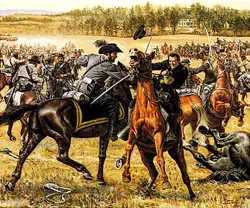Civil War Battles |
Colonial Wars |
American Wars |
Link To This Page — Contact Us —
The Battle of Yellow Tavern
May 11, 1864 in Henrico County, Virginia
Grant's Overland Campaign
Union Forces Commanded by:
Maj. Gen. Philip Sheridan
Confederate Forces Commanded by: Maj. Gen. J.E.B. Stuart
**Missing and Captured Conclusion: Union Victory |
 |
BATTLE SUMMARY
The Battle of Yellow Tavern was a clash between the Union and Confederate cavalry forces. It was best known for the mortal wounding of legendary Confederate cavalry commander Maj. Gen. J.E.B. Stuart.The Overland Campaign was Lt. Gen. Ulysses S. Grant's 1864 offensive against Gen. Robert E. Lee's Army of Northern Virginia. The two had fought an inconclusive battle at the Wilderness and were engaged in heavy fighting at the Battle of Spotsylvania Court House. Up to this point, Union cavalry commander Maj. Gen. Philip Sheridan was dissatisfied with his role in the campaign. His Cavalry Corps was assigned to the Army of the Potomac, under Maj. Gen. George G. Meade, who reported to Grant. Meade had employed Sheridan's forces primarily in the traditional role of screening and reconnaissance, whereas Sheridan saw the value of wielding the Cavalry Corps as an independently operating offensive weapon for wide ranging raids into the rear areas of the Confederates.
On May 8, as the battle between Gen. Ulysses S. Grant and Gen. Robert E. Lee raged at Spotsylvania Court House, Maj. Gen. Philip H. Sheridan went over Maj. Gen. George G. Meade's head and told Grant that if his Cavalry Corps were let loose to operate as an independent unit, he could defeat Stuart, long a nemesis to the Union army. Grant was intrigued and convinced Meade of the value of Sheridan's request. Grant, appreciating Sheridan's bravery and fighting spirit, said "Let him start right out and do it."
On May 9, Sheridan set out with the most powerful cavalry force the Army of the Potomac had ever mounted -- more than 10,000 troopers with 32 guns. It was also the most powerful cavalry force ever seen in the Eastern Theater. They rode to the southeast to move behind Lee's army. They had 3 goals: first, disrupt Lee's supply lines by destroying railroad tracks and supplies; second, threaten the Richmond, which would distract Lee; third, and most important, defeat Stuart.
They moved at a walk, 4 abreast in a column that stretched for 13 miles. Sheridan was so confident of success that he made no effort to hid his movements.
The column reached Lee's forward supply base at Beaver Dam Station by nightfall. The Confederate depot guards had set fire to their supplies before the Union troops arrived, but the Union force found other material to destroy: 100 railroad cars and 6 locomotives -- 1/4 of Virginia Central Railroad's rolling stock.
The Union cavalry column reached the Confederate forward supply base at Beaver Dam Station that evening. The Confederate troops had been able to destroy many of the critical military supplies before the Union arrived, so Sheridan's men destroyed numerous railroad cars and 6 locomotives of the Virginia Central Railroad, ripped up 10 miles of track, pulled down telegraph wires, and freed 378 of their men who had been taken prisoner during the Battle of the Wilderness.
On May 11, Stuart, told of Sheridan's force and direction, moved with 4,500 troopers to get between the Union column and Richmond. After disrupting Lee's road and rail communications, Sheridan's cavalry expedition climaxed with the battle of Yellow Tavern, an abandoned inn 6 miles north of Richmond.
For 3 hours, the opposing cavalry forces fought, with the outnumbered Confederate troops stubbornly defending their position. Not only did the Union outnumber the Confederates by 3 divisions to 2 brigades, it had superior firepower, being armed with rapid-firing Spencer carbines. Sheridan had hurled his well rested cavalrymen against Stuart's tired men, who held defensive positions along ridges bordering the road to Richmond. The outnumbered Confederate cavalry was defeated.
An unhorsed Union private fired a single shot at a large, red-bearded Confederate officer on a horse 30 feet away. Stuart was mortally wounded and would die the next day. Lee had lost his greatest cavalry officer. The fighting kept up for an hour after Stuart was wounded, with Maj. Gen. Fitzhugh Lee taking temporary command. Sheridan continued his attacks on the Confederate position for an hour. The Confederates were slowly forced to give way. Then Sheridan called his men back from "this obstinate contest" and headed south toward Richmond, only 6 miles away.
Sheridan continued south to threaten the Richmond defenses before joining Butler's command at Bermuda Hundred. They reached the outer defenses of the South's capital before night, and Sheridan was tempted to bust right through. After refitting, Sheridan rejoined the Army of the Potomac on May 25 for the march to the southeast and the crossing of the Pamunkey.
Besides, Sheridan's real goal had been Stuart all along, not Richmond. Fitzhugh Lee's troopers, bolstered by infantry from Richmond, slashed at the Union cavalry rear and flanks as they retreated east and then south across the Chickahominy River to Gen. Benjamin Butler's Union force on the James River.
Sheridan's raid had been an unqualified success. Their most significant victory, however, was killing Stuart. This deprived Lee of his most experienced cavalry commander.
